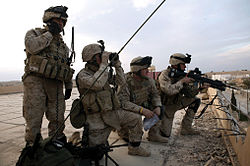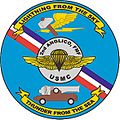History
ANGLICO dates back to World War II and the island-hopping strategy in the Pacific Theater. It was realized that there was a need to coordinate air, naval and artillery gunfire support between the Marines, Navy, Army, and other Allied forces. A Joint Assault Signal Company (JASCO) was created and attached to the 4th Marine Division.
The first use of JASCO was in the Marshall Islands campaign during the assault on Roi Namur. It was subsequently deployed in the Marianas campaign, for the capture of Tinian and Saipan. The unit proved to be so effective that five other JASCOs were created. Perhaps the most famous JASCO is the 594th, for its actions during the Battle of Okinawa (1945) and the Philippines campaign (1944–45). [2]
Following the reorganization of US armed forces in 1947, under the Department of Defense, the primary responsibility for liaison between seaborne fire support and ground forces was transferred to the Navy; consequently the JASCOs were disbanded.
However, in 1949, the Marine Corps began the process of recreating the capability, under the ANGLICO designation. The first such unit, ANGLICO, 2nd Signals Battalion, 2nd Marine Division, was formed in December, 1949 at Camp Lejeune, North Carolina. 1st Marine Division formed a similar unit at around the same time: ANGLICO, 1st Signal Battalion, 1st Marine Division. A third unit, 1st ANGLICO, Fleet Marine Force, Pacific, was activated on 2 March 1951 at Pearl Harbor, Hawaii. [2] The ANGLICOs within 1st and 2nd Marine Divisions saw combat throughout 1950 and 1951 in the Korean War. Detachments from these units also saw combat attached to Republic of Korea Marine Corps battalions, and US Army units.
In May 1965, 1st ANGLICO activated Sub Unit One, for duty during the Vietnam War, in which the unit was continuously deployed for eight years. Sub Unit One's first commanding officer was LtCol George H. Albers. It was the only Marine Corps organization reporting directly to Military Assistance Command, Vietnam which assumed operational control of the sub unit in September 1966. Throughout its involvement in Vietnam Sub Unit One NGLO and TACP teams operated in all four tactical zones and was the last Fleet Marine Force unit to stand down from the war. Sub Unit One provided naval gunfire and close air in support of South Vietnamese Army and Marine units, South Korean Army and Korean Marine units, Australian Army, and New Zealand Army, as well as US Army and Marine combat formations. While only an estimated 1,350 men served the sub unit over those eight years they contributed in no small way to almost every combat operation of the war. In March 1972, naval gunfire spotters directing fire from the gunline ships of the US Navy provided the only counter-battery fire directed at North Vietnamese artillery that hit I Corps in advance of the Easter Offensive. Unit strength at that time was only 107 officers and men both Navy and Marine who with their backs to the wall made up the numbers deficit by tenaciously providing around the clock support. [2]
In the late 1970s, under the leadership of LtCol James E. Toth, 2nd ANGLICO began experimenting with the concept of the "Universal Spotter": a Marine trained to coordinate and control fires from artillery, naval gunfire, and Close Air Support (CAS); previously the organization of ANGLICO, USMC artillery and infantry units provided separate shore fire control party teams, artillery liaison and tactical air control party teams for the observation and control of supporting arms for both USMC and other forces maneuver units. The experimental concept relied on company level teams known as Firepower Control Teams (FCTs) containing personnel and equipment to control fires for all supporting arms and battalion level groups known as Supporting Arms Liaison Teams (SALTs) responsible for coordination of all supporting arms renabled 2nd ANGLICO to greatly reduce the number personnel required to support US Army and allied units and streamlined the request for and approval of the delivery of terminal control of USMC and USN supporting arms. The Universal Spotter concept was later adopted by all ANGLICOs and was the forerunner of today's Joint Terminal Attack Controller (JTAC) and Joint Fires Observers (JFO).
The early 1980s saw ANGLICOs (particularly 2nd ANGLICO) operating at a high tempo; between June 1982 and March 1984, the company supported 35 operations with US Army and Allied nations, ranging from arctic operations in northern Norway, exercises in the Mediterranean, TACP support for USN carrier wings in the Caribbean and training operations with South American militaries. Additionally, elements of the company participated in sensitive peacekeeping operations in Beirut, Lebanon for the PLO evacuation and subsequently the Multi-national Peace Keeping Force. 2nd ANGLICO teams supported British, Italian, French and Lebanese Army elements and engaged enemy targets on several occasions via USMC, USN and Lebanese supporting arms, including 16" naval gunfire from the USS New Jersey and 122mm rocket fire from Lebanese Army BM21 multiple rocket launchers. A 2nd ANGLICO SALT officer conducted naval gunfire spotting from an A-6 Intruder, the first time this had been done from this platform.
Also, despite having nearly a third of its strength engaged internationally, for the first time in its history 2nd ANGLICO deployed in support of 18th Airborne Corps for Operation Urgent Fury (Invasion of Grenada). This was also the first time an entire US Army Division, the 82nd Airborne Division was supported during combat operations. 2nd ANGLICO teams airlanded at Point Salines airfield with the division's first elements and controlled USN LTV A-7 Corsair II aircraft in close air support and assisted in deconflicting indirect fires from Army units.
During the mid-to-late 1980s, under LtCol J. M. Wills and LtGen A. M. Gray (later Commandant of the Marine Corps) 2nd ANGLICO went through a period of refocusing on core skills including regular live naval gunfire training with the USS Iowa battleship, and more frequent mass tactical exercises with the Army's 82nd Airborne Division. Additionally, the 2nd ANGLICO began to train in Low Intensity Conflict response with weapon systems such as the Air Force AC-130 Spectre, Special Patrol Insertion/Extraction and Fast Rope insertion methods.
In 1999, all active-duty ANGLICO units (1st and 2d ANGLICO) were deactivated, their responsibilities transferred to Marine Liaison Elements. The two reserve units, 3rd and 4th ANGLICO, were the only ANGLICO units that remained (and to this day are the only ANGLICOs that retain their jump mission and status as "Goldwingers," a reference to the ANGLICO personnel being jump qualified and entitled to wear the Navy and Marine Corps Parachutist insignia. In 2003, amidst the US war in Iraq and Global War on Terror and a high operational tempo being demanded of the reserve ANGLICO units, 1st and 2d ANGLICO were reactivated (although their status as jump units has never returned). Shortly thereafter, in 2004, 5th ANGLICO was formed.
In early 2003, The Fourth Marine Division, 4th ANGLICO Marines of West Palm Beach Florida were activated to support Operation Iraqi Freedom. 4th ANGLICO Detachment Alpha was sent to Qatar where it would await orders from the Special Operations Coalition. The team was set to work with 10th SFG in North Iraq; the insertion plans did not materialize; the team was held in standby.
Detachment Bravo was activated from West Palm Beach and would go to Camp Commando Kuwait and enter Iraq in late 2003. Serving in Operation Iraqi Freedom in 2003-2004, 4th ANGLICO Det Bravo Teams, Lightning one-zero, Lightning two-zero and Lightning three-zero, would go on to play a crucial role in South Iraq, earning combat action ribbons and combat Valor “V” Medals for fighting the Al-Mehdi Army.
On 4 April 2004 the Al-Mehdi Army uprising was the first large scale “clash” with the ANGLICOs in Al-Kut and An-Najaf. Lightning two-Zero was in An-Najaf as a Quick Reaction Force.
04 April 2004 An-Najaf and Al-Kut, Iraq:
“The Madi-Army also struck at (other) compounds in early April in which marines played a pivotal role in their defense. A Spanish military Garrison in an-Najaf was all but abandoned and left for the enemy hands. If not for the actions of Captain Matthew Brannen and Staff Sergeant Derrick Leath Reservists from fourth ANGLICO out of West Palm Beach, Florida while Spanish soldiers evacuated the base. The two marines led a small contingent of only seven men (FCT 2) to save it from the militia. While militia men attacked with small arms and mortars, Brannen and Leath (FCT 2) fought back by calling in air support. For about three weeks, they orchestrated 20 airstrikes and defended the base’s perimeter with individual weapons. “
THREE BLOCK WAR II “Snipers in the Sky” By Matt Zeigler
Four members of 4th ANGLICO were awarded Bronze Star medals with combat “V” for heroism against the enemy in this first clash: Major James R. Purmort II, Staff Sergeant Andre Rivera in Al-Kut, and Captain Matt Brannen and Staff Sergeant Derrick Leath in An-Najaf, Iraq. Their team members were also given combat “Valor” medals.
These “first clash” of fighting battles with the Al-Mehdi Army in Al-Kut and An-Najaf, would be the precursor to the battle of An-Najaf and the major battles in the cemetery with the 11th Marine Expeditionary Unit in August of 2004.
Lightning Two-Zero was a 7 Marine Team that was a Quick Reaction Force for all of South Iraq. This Team of 7 fought alongside various Multinational Units, US Army SF, and Contractors. ANGLICO Marines would go on to be decorated throughout the unit with Combat Valor for years to come. Other 4th ANGLICO Detachments would follow with valor and heroism from the 4th ANGLICO Det Alpha, Bravo, Charlie, Delta, Echo and Fox, would all serve in Operation Iraqi Freedom.
4th ANGLICO would additionally, and simultaneously go on to support Operations in Afghanistan, Operation Enduring Freedom. 4th ANGLICO was at the forefront of both wars on both battlefronts in Iraq and Afghanistan proving the 4th ANGLICO was a major player in a combat role. These specialized unit of Marines supporting various coalition units, special operations forces, and conventional forces throughout both wars, contemporaneously.
“ANGLICO is now reinventing itself as an organization closely associated with Special Operations, but with a mission and organizational structure unlike any other. It is now the key dynamic in supplying leveraged firepower in support of small units involved in distributed operations. Studds explained, “We also work independently a lot with [Marine] division operations to accomplish missions that they need, and we also work with Special Forces much of the time to train the Iraqi army and the police services in the area. We work up intel packages with the Special Forces for the force commander.” One of ANGLICO’s teams operated exclusively with the al Hillah police special weapons and tactics teams 75 miles south of Baghdad,” Lt Col Studds,
Leatherneck Magazine, 2007 PG.45 Lt Col. Studds
In 2008, ANGLICO began supporting combat operations in Helmand Province, Afghanistan, in support of Operation Enduring Freedom. A detachment from 2nd ANGLICO was sent as part of SMAGTF-A, and in 2009, the brigade platoon from 2nd, followed by a detachment from 1st ANGLICO and one from 3rd, joined the 2nd Marine Expeditionary Brigade. [3]
In 2013, 6th ANGLICO was formed in Concord, California, [4] with a third brigade platoon detachment at Joint Base Lewis-McChord, Washington. In 2018, 6th ANGLICO relocated the HQ and a brigade platoon to Joint Base Lewis-McChord, Washington. In 2019, the final Brigade Platoon was relocated to JBLM and the Concord Reserve Training Center was turned over to Marine Corps Advisor Company Bravo.







